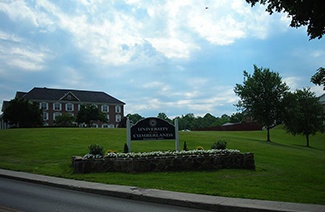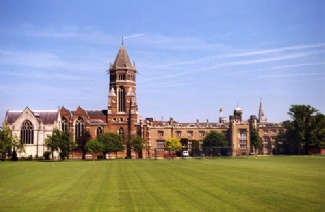2014年2月28日,希望对各位考生的备考有所帮助,祝每位烤鸭考试顺利,都能取得好成绩!
2014年2月28日北美地区
第一篇:过去的气候 weather in the past
讲研究遥远过去气候的各种方法,主要围绕冰川、冰盖等研究展开。
解析:本文属地质学话题,研究地球气候变化情况。这是托福阅读常考话题,气候也常常作为研究其他历史现象或事件背后的可能原因而出现。
Vostok Research Station
Vostok Research Station is about 1,300 km from the Geographic South Pole, at the center of the East Antarctic Ice Sheet and within the Australian Antarctic Territory. As a signatory to the Antarctic Treaty System, Australia does not exercise sovereignty over the territory.
Vostok is located near the Southern Pole of Inaccessibility and the South Geomagnetic Pole, making it one of the optimal places to observe changes in the Earth's magnetosphere. Other studies include actinometry, geophysics, medicine and climatology.
The station is at 3,488 meters (11,444 ft) above sea level and is one of the most isolated established research stations on the Antarctic continent. The station was supplied from Mirny Station on the Antarctic coast. The station typically contains 25 scientists and engineers in the summer. In winter, their number drops to 13.
The only permanent research station located farther south is the Amundsen–Scott South Pole Station, operated by the United States at the geographic South Pole.
Some of the challenges faced by those living on the station were described in Vladimir Sanin's books such as "Newbie in the Antarctic" (1973), "72 Degrees Below Zero" (1975), and others.
In the 1970s the Soviet Union drilled a set of cores 500–952 m deep. These have been used to study the oxygen isotope composition of the ice, which showed that ice of the last glacial period was present below about 400 m depth. Then three more holes were drilled: in 1984, Hole 3G reached a final depth of 2202 m; in 1990, Hole 4G reached a final depth of 2546 m; and in 1993 Hole 5G reached a depth of 2755 m; after a brief closure, drilling continued during the winter of 1995. In 1996 it was stopped at depth 3623 m, by the request of the Scientific Committee on Antarctic Research that expressed worries about possible contamination of Lake Vostok. This ice core, drilled collaboratively with the French, produced a record of past environmental conditions stretching back 420,000 years and covering four previous glacial periods. For a long time it was the only core to cover several glacial cycles; but in 2004 it was exceeded by the EPICA core, which whilst shallower, covers a longer time span. In 2003 drilling was permitted to continue, but was halted at the estimated distance to the lake of only 130 m.
The ancient lake was finally breached on 5 February 2012 when scientists stopped drilling at the depth of 3770 meters and reached the surface of the sub-glacial lake.
The brittle zone is approximately between 250 and 750 m and corresponds to the Last Glacial Maximum,[18] with the end of the Holocene climatic optimum at or near the 250 m depth.
Although the Vostok core reached a depth of 3623 m the usable climatic information does not extend down this far. The very bottom of the core is ice refrozen from the waters of Lake Vostok and contains no climate information. The usual data sources give proxy information down to a depth of 3310 m or 414,000 years. Below this there is evidence of ice deformation. It has been suggested that the Vostok record may be extended down to 3345 m or 436,000 years, to include more of the interesting MIS11 period, by inverting a section of the record. This then produces a record in agreement with the newer, longer EPICA record, although it provides no new information.#p#副标题#e#
第二篇
TOPIC 美国钢铁的发展和作用 steel in United States industrialized economics
讲美国1860-1940年的经济发展中,钢(steel)和铁(iron)起到了巨大的作用。钢铁制造的机器进行的精确切割使得标准化流水线(standardized assembly line)作业成为可能。钢铁发展也催生了美国著名的钢铁之城匹兹堡和克利夫兰。
解析:本文属历史类话题,主要谈及美国经济史。托福阅读考察美利坚合众国历史主要是从经济角度入手,曾经考察过如美国经济大萧条、美国风力发电发展等内容。考生在日常学习中可以适当补充该方面知识。
The Bessemer Process in the United States
While visiting Europe to obtain information on shipbuilding, armor, and armaments from 1862-1863, Alexander Lyman Holley visited Bessemer's Sheffield works, and expressed interest in licensing the process for use in the US. Upon returning to the US, Holley met with the famous inventor John Ericsson, who referred Holley to a pair of businessmen who had helped him build the Civil War ironclad USS Monitor, John F. Winslow and John Augustus Griswold. With Winslow and Griswold's support, Holley returned to England in 1863, and paid Bessemer £10,000 to license the technology. The trio began setting up a mill in Troy, New York in 1865. The factory contained a number of Holley's innovations that greatly improved productivity over Bessemer's factory in Sheffield, and the owners gave a successful public exhibition in 1867. The Troy factory attracted the attention of the Pennsylvania Railroad, who wanted to use the new process to manufacture steel rail, and ended up funding Holley's second mill as part of its Pennsylvania Steel subsidiary. Between 1866 and 1877, the partners were able to license a total of 11 Bessemer steel mills. One of the investors they attracted was Andrew Carnegie, who saw great promise in the new steel technology after a visit to Bessemer in 1872, and saw it as a useful adjunct to his existing businesses, the Keystone Bridge Company and the Union Iron Works. Holley built the new steel mill for Carnegie, and continued to improve and refine the process. The new mill, known as the Edgar Thomson Steel Works, opened in 1875, and sparked the growth of the United States as a major world steel producer.#p#副标题#e#
第三篇:语言学作为历史研究的资料linguistic as a source of historical study.
讲通过语言的发展我们可以看到世界上过去几次人类大规模的迁徙(great immigration)方向--比如从中亚到东欧再到西欧。这就是语言学,通过研究词汇vocabulary,语法grammar,结构structure为历史研究提供了资料。
解析:本文属语言学与历史学话题结合内容。语言学在托福阅读中考察较少,更多也是从语言学为历史研究服务的角度来去考察。例如在TPO中曾通过研究各个地区语言的相似性来得知历史上某些民族某些种族所生活覆盖影响的范围。
Glottochronology
Glottochronology (from Attic Greek γλῶττα “tongue, language” and χρóνος “time”) is that part of lexicostatistics dealing with the chronological relationship between languages.
The idea was developed by Morris Swadesh under two assumptions: First that there exists a relatively stable "basic vocabulary" (therefore called "Swadesh lists") in all languages of the world, and secondly that any replacements happen in a way analogical to that in radioactive decay in constant percentages per time elapsed. Meanwhile there exist many different methods, partly extensions of the Swadesh method, now more and more under the biological assumptions of replacements in genes. However, Swadesh's technique is so well known that, for many people, 'glottochronology' refers to it alone.
The original method presumed that the core vocabulary of a language is replaced at a constant (or constant average) rate across all languages and cultures, and can therefore be used to measure the passage of time. The process makes use of a list of lexical terms. Lists were compiled by Morris Swadesh and assumed to be resistant against borrowing (originally designed in 1952 as a list of 200 items; however, the refined 100 word list in Swadesh (1955) is much more common among modern day linguists). This core vocabulary was designed to encompass concepts common to every human language (such as personal pronouns, body parts, heavenly bodies, verbs of basic actions, numerals 'one' and 'two', etc.), eliminating concepts that are specific to a particular culture or time. It has been found that this ideal is not in fact possible and that the meaning set may need to be tailored to the languages being compared. Many alternative word lists have been compiled by other linguists, often using fewer meaning slots.
The percentage of cognates (words that have a common origin) in these word lists is then measured. The larger the percentage of cognates, the more recently the two languages being compared are presumed to have separated.
The Indo-European languages
The Indo-European languages are a family of several hundred related languages and dialects. There are about 439 languages and dialects, according to the 2009 Ethnologue estimate, about half (221) belonging to the Indo-Aryan subbranch. It includes most major current languages of Europe, the Iranian plateau, and the Indian Subcontinent, and was also predominant in ancient Anatolia. With written attestations appearing since the Bronze Age in the form of the Anatolian languages and Mycenaean Greek, the Indo-European family is significant to the field of historical linguistics as possessing the second-longest recorded history, after the Afro-Asiatic family.
Indo-European languages are spoken by almost 3 billion native speakers, the largest number by far for any recognised language family. Of the 20 languages with the largest numbers of native speakers according to SIL Ethnologue, 12 are Indo-European: Spanish, English, Hindi, Portuguese, Bengali, Russian, German, Punjabi, Marathi, French, Urdu, and Italian, accounting for over 1.7 billion native speakers. Several disputed proposals link Indo-European to other major language families.#p#副标题#e#
第四篇:深海生物的多样性biodiversity of the deep sea
讲深海生物多样性情况,在不同的海洋区域生物多样性有不同。还提到了海洋和陆地之间的生物多样性比较。
解析:本文属典型的生物学话题,围绕海洋生物生态展开。生物多样性是托福阅读常考话题,也是生物学中非常重点的一个关注焦点。
Marine Biology
Marine biology is the scientific study of organisms in the ocean or other marine or brackish bodies of water. Given that in biology many phyla, families and genera have some species that live in the sea and others that live on land, marine biology classifies species based on the environment rather than on taxonomy. Marine biology differs from marine ecology as marine ecology is focused on how organisms interact with each other and the environment, and biology is the study of the organisms themselves.
A large proportion of all life on Earth exists in the ocean. Exactly how large the proportion is unknown, since many ocean species are still to be discovered. The ocean is a complex three-dimensional world covering about 71% of the Earth's surface. Because of its depth it contains about 300 times the habitable volume of the terrestrial habitats on Earth. The habitats studied in marine biology include everything from the tiny layers of surface water in which organisms and abiotic items may be trapped in surface tension between the ocean and atmosphere, to the depths of the oceanic trenches, sometimes 10,000 meters or more beneath the surface of the ocean. Specific habitats include coral reefs, kelp forests, seagrass meadows, the surrounds of seamounts and thermal vents, tidepools, muddy, sandy and rocky bottoms, and the open ocean (pelagic) zone, where solid objects are rare and the surface of the water is the only visible boundary. The organisms studied range from microscopic phytoplankton and zooplankton to huge cetaceans (whales) 30 meters (98 feet) in length.
Marine life is a vast resource, providing food, medicine, and raw materials, in addition to helping to support recreation and tourism all over the world. At a fundamental level, marine life helps determine the very nature of our planet. Marine organisms contribute significantly to the oxygen cycle, and are involved in the regulation of the Earth's climate. Shorelines are in part shaped and protected by marine life, and some marine organisms even help create new land.

















